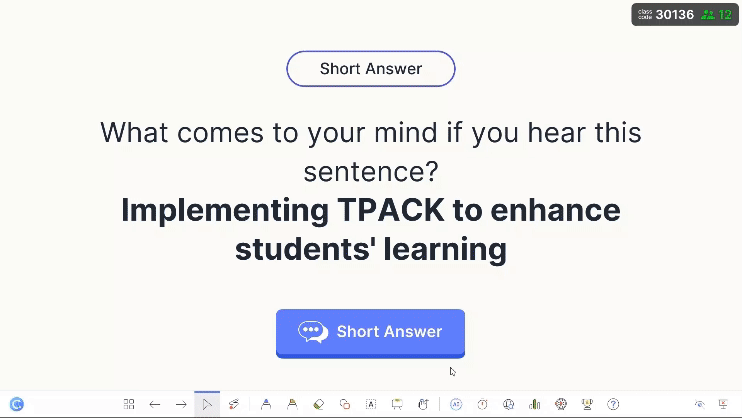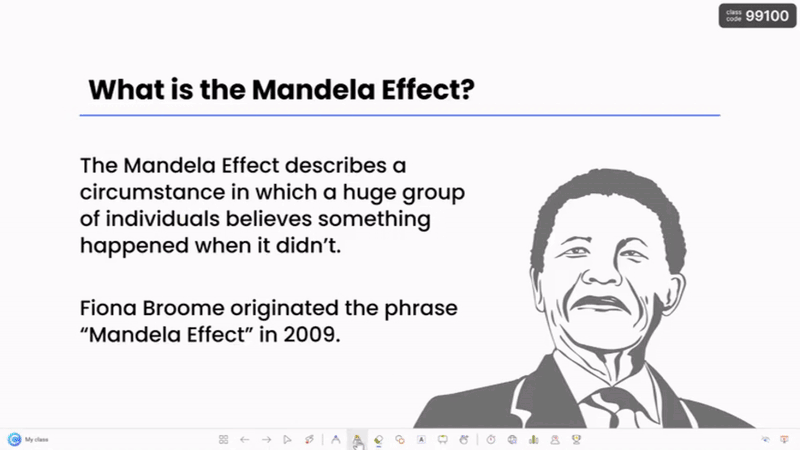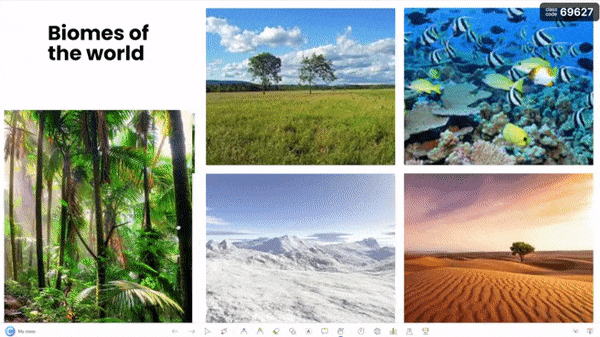Let’s start by throwing out the biggest myth in presenting: that audience participation means getting people to raise their hands or answer questions out loud. That’s actually surface-level.
Real participation begins well before that. It starts when people decide whether or not they trust you enough to mentally lean in.
Most presenters mistake silence for disinterest, when it’s absolutely not. Because you shouldn’t be zooming in to getting people to talk. It’s to lower the barrier for them to want to join in.
That shift, from expecting energy to designing for it, is where the real work begins.
Now let’s talk about how to warm the room without saying a word.
1. Warm the Room Without Saying a Word
The first few minutes of your session are your silent handshake. And no, it doesn’t start with your voice. It starts with the room before you speak.
Most presenters walk in, plug in their devices, and goes straight to fiddling with slides. That right there is missed opportunity.
If you’re serious about participation, your presence starts at setup. A few things:
- Change the seating layout. Even slightly. A few chairs in a semicircle. A cluster of seats up front. Anything that says “this isn’t like the last session.” It is crucial to break the autopilot.
- Stand away from the lectern. Not forever, of course. Just during the time people walk in. It tells them you’re not hiding behind the tech.
- Use pre-arrival cues. Music playing low. A slide with a provocative question. A quote. A poll already live. Something ambient that doesn’t demand attention but actively looks for curiosity.
The idea is quite simple: You’re showing that this room will run differently, even just a little bit.
2. Design Your Slides to Invite Audience Participation
Your slides set the tone for how involved your audience feels, whether you realize it or not.
If every slide is packed with conclusions, there’s nothing left for people to consider. You’ve closed the loop before they could step in.
Look for moments where you can hold back just enough to make the audience do a bit of thinking, like a slide with a question you don’t immediately answer.
When you’re ready to invite the room in, keep the friction low with a quick live poll, or maybe a short open-ended response. These take seconds, but they completely change the dynamic.
Check out this curated list of 30 PowerPoint Presentation Tips for Better Slides and Delivery.
With ClassPoint, you can add those moments directly to your PowerPoint without switching tools or breaking rhythm. It keeps your flow intact while giving the audience on-the-spot cues to participate and voice out.

3. Plant Silent Prompts Early
One of the easiest ways to encourage audience participation is to quietly build it into your session from the start.
You do that by planting prompts that challenge people to think, so they (are a little pressured, really) don’t zone out.
A few ideas:
| Technique | What It Does | How to Use It in Real-Time |
|---|---|---|
| Rhetorical Questions | Creates instant reflection without expecting response | Ask a strategic “What would happen if…” or “Why do we still do it this way?” |
| Linger & Pivot | Gives space for internal reaction, keeps the session moving | Drop a strong point, hold for 2 seconds, then move on |
| Self-Answering Questions | Guides the audience toward a shared conclusion without asking for a show of hands | Try: “If we’ve already done X three times, do we really need Y?” |
None of these techniques need a mic or a raised hand. They just need timing and tone from you who commands the presentation.
4. Us Participation Anchors, Not Triggers
There’s a difference between asking people to participate and giving them a reason to.
Triggers are one-off interactions. Anchors are recurring. What counts?
- A key phrase you plant early and revisit throughout the session
- A single compelling question that builds tension until it’s resolved
- A story or example that evolves in stages, with the audience filling in the gaps
- A visual or recurring motif that becomes a mental checkpoint
Anchors only work when you commit to them. And when you do, they become powerful cues for audience participation, as you actively call back something your audience has been sitting with.
ClassPoint’s annotation tools are particularly helpful for anchors. When you revisit an anchor slide, you can mark it live: add emphasis, draw a connection, circle something you didn’t the first time. It reinforces that this isn’t a one-and-done idea. You’re building on it.

Another effective hack is using ClassPoint’s Draggable Objects, which allows you to set up visual elements on your slide, which you can move (as its feature name suggests, drag and drop, literally) throughout your live slide show as dynamic visual cues.

Here's a quick, no-brainer guide on How to Drag and Drop Objects in PowerPoint Like a Pro!
5. Master the Invisible Hand Raise
If there’s one moment presenters routinely mishandle, it’s asking for questions. You get to the end of a section, say, “Any questions?”, and then, silence.
It’s not that they don’t have questions. It’s that you just made it feel like a pop quiz in front of 30 people.
Instead, change your approach. Keep control of the flow while inviting engagement more naturally.
- Say: “Here’s a question I often get at this point…” It lowers the stakes. You’re not asking for a question. You’re giving them permission to have one.
- Or: “Turn to someone near you and guess the answer. What would you say?” Peer-to-peer engagement gives people a low-pressure way to think through the material without having to speak publicly.
ClassPoint Tip: Spin a fun, ice-breaking Wheel of Names when you want to gently bring someone in without putting them on the spot.
6. Know When to Leave Them Alone
Every room has spectators. If they stay that way all throughout, that’s okay.
Experienced presenters learn to recognize the difference between disengaged and self-contained. If someone’s following along, even silently, they’re participating in their own way. They don’t owe you a hand raise.
What you can do:
- Design moments that allow private wins, like a short written reflection, a one-word response, or a pair share that never goes public.
- Avoid language like “Everyone must…” or “I need someone to…” That’s your anxiety talking. It makes the room smaller.
- Shift your attention toward momentum, not consensus. If ten people lean in while three lean out, you’re doing fine.
7. Stick the Cognitive Landing
If your ending sounds like a wrap-up, you’ve already lost them.
The close of a participatory session is where you introduce just enough tension to keep the idea moving after the room empties.
That’s the difference between a presenter and a facilitator. A presenter summarizes. A facilitator leaves people thinking, questioning, not quite done.
- Drop an intellectual provocation. Present something just out of reach. Something they’ll want to argue with in the hallway: “If this works so well, why haven’t we already changed it?”
- Reposition the audience as carriers of the idea. Give them something to spot, apply, or test within the next 24 hours: “This framework only lives if it shows up in your next conflict.”
- Introduce deliberate asymmetry. If your session opens with clarity, close with a loose thread, like a half-answered question. It makes the content feel alive, unfinished even, as it should be.
Here’s a Bonus Tip Before You Go
You can have a polished deck, strong delivery, and confident pacing, but still struggle to get audience participation. That’s not always your issue. Sometimes, it’s the format.
If you want real engagement, you need to start integrating something new into the structure itself. And, ClassPoint can definitely help.
It lets you run low-stakes, on-the-spot quizzes directly inside PowerPoint as you run your presentation live. The audience responds from their own devices, silently and comfortably (sometimes anonymously). Their answers show up live on the slide you’re actively presenting, making it a whole-room interaction rather than a spotlight on a single person.
It’s also equipped with tools like the Embedded Browser, a live slide show timer, and even an AI quiz generator that give you flexibility in the moment.
FAQs
How do I prevent audience participation from turning into audience takeover?
Set clear parameters. Say upfront how participation will happen, whether through structured activities, time-limited responses, or anonymous input. When the audience knows you’re leading the structure, they’ll trust the process.
What’s a smart way to reward audience participation without calling people out?
Use systems like ClassPoint’s star awards. You can recognize input subtly on-screen without forcing a spotlight moment. It gives reinforcement to those engaging while keeping the environment low-pressure.
Is it possible to layer audience participation so it deepens over time?
Yes. The best sessions don’t treat participation as isolated tasks. They scaffold it. Start with quick polls or gestures. Then move into short written prompts. By the time you open for verbal discussion, people have already been engaging privately.
What are signals that your audience participation strategy is too safe?
If every interaction ends in unanimous agreement, you’re not inviting real thought. Good audience participation leaves space for contradiction, discomfort, or tension. When no one’s taking a second to think before answering, or you’re only getting surface-level responses, your format may be too easy to coast through.
How do I handle participation fatigue in long sessions or trainings?
Don’t spread interaction evenly. Instead, concentrate it where it counts. Use audience participation when attention dips (right after lunch, mid-way through dense content) or when you introduce an idea that benefits from friction.
